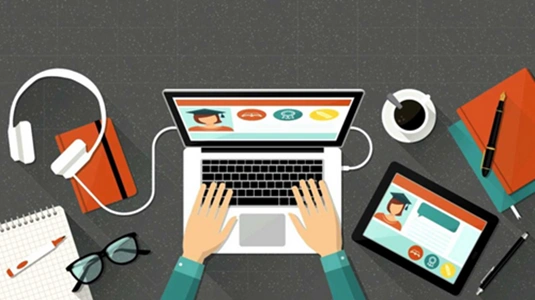E-learning has transformed education by making knowledge accessible to learners worldwide. With the increasing demand for digital learning materials, educators and content creators are constantly looking for tools to enhance engagement and improve learning outcomes. One such innovation is AI slideshow makers, which automate the process of creating visually appealing and informative presentations. These tools use artificial intelligence to streamline content creation, making it easier for educators to develop structured, interactive, and engaging slideshows.
This article explores how AI-powered slideshow makers contribute to e-learning, their benefits, and how they integrate with modern digital learning platforms.
How AI Slideshow Makers Enhance E-Learning

1. Automated Content Structuring
Creating a well-organized presentation is crucial in e-learning, as a structured approach improves information retention. AI slideshow makers analyze text input and automatically generate a coherent slide layout. These tools use machine learning algorithms to segment information, ensuring each slide presents key points clearly.
For educators, this eliminates the need to manually format slides, saving time and allowing them to focus on content quality. AI-powered tools can also suggest slide sequences based on best practices, making presentations more logical and engaging.
2. Visual and Multimedia Integration
E-learning relies heavily on visual elements such as images, videos, and infographics to enhance understanding. AI slideshow makers can automatically suggest relevant visuals, arrange them optimally, and even enhance them using filters and effects.
Additionally, AI-driven tools support multimedia integration, allowing educators to incorporate voiceovers, animations, and interactive elements. This improves engagement, making learning more dynamic compared to traditional text-based slides.
3. Customization and Personalization
Personalized learning is a growing trend in e-learning, where content adapts to individual learner needs. AI slideshow makers provide customization options that allow educators to modify themes, fonts, and layouts to align with different learning styles.
Some tools even analyze past content to recommend design styles and presentation formats that best suit a particular audience. By using AI-generated slideshows, educators can create content that resonates with learners, improving comprehension and retention.
Integrating AI Slideshow Makers with Other E-Learning Tools
1. Enhancing Video-Based Learning
Videos play a significant role in digital education. AI slideshow makers can convert slides into engaging video presentations, making content more accessible across different platforms. This is particularly useful for e-learning courses, where instructors often combine slideshows with recorded lectures.
For learners who prefer visual learning, slideshows with AI-generated animations and transitions can make complex topics easier to understand. The ability to add voice narration and background music further enhances the learning experience.
A variety of video apps integrate AI-generated slideshows into video content, enabling educators to create professional-quality instructional videos with minimal effort. These apps provide templates and editing tools that automate the process, making video-based learning more efficient.
2. Interactive and Gamified Learning
AI-powered slideshow makers are increasingly being used in gamified e-learning experiences. By incorporating interactive elements such as quizzes, clickable links, and animations, educators can make learning more engaging. AI algorithms can also adjust slides based on learner performance, creating an adaptive learning environment.
For example, an AI slideshow maker can generate multiple-choice questions at the end of each module and update slides based on student responses. This dynamic approach enhances learner participation and reinforces key concepts.
3. Seamless Content Creation for Online Courses
Many online courses rely on high-quality visual presentations to deliver information effectively. AI slideshow makers simplify course creation by automating slide design, ensuring consistency across modules.
Educators can input raw text, and AI tools will format it into well-structured slides with relevant images and animations. This reduces the time required to develop course materials while maintaining a professional appearance.
A well-structured AI slideshow generator allows educators to quickly create lesson plans, tutorials, and summaries. By automating repetitive design tasks, AI tools make it easier to produce large volumes of educational content efficiently.
Benefits of AI Slideshow Makers in E-Learning
1. Time Efficiency
Manually designing slideshows can be time-consuming, especially for educators handling multiple courses. AI automates slide creation, reducing the effort required to produce high-quality presentations.
2. Consistency in Design
Maintaining a uniform design across multiple lessons enhances the learning experience. AI slideshow makers apply consistent themes, fonts, and colors, ensuring a professional look.
3. Improved Learner Engagement
Interactive and visually appealing slideshows capture learner attention better than plain text. AI-generated transitions, animations, and multimedia elements enhance engagement and retention.
4. Accessibility for Diverse Learners
AI-powered slideshows can be converted into multiple formats, such as PDFs, videos, and interactive web presentations. This ensures accessibility for learners with different preferences and needs.
5. Scalability for Institutions
Educational institutions and online course providers can use AI slideshow makers to produce large-scale learning materials efficiently. This is particularly useful for creating standardized course modules.
Challenges and Future Potential
1. Dependence on AI Automation
While AI streamlines the process, educators must still review and refine AI-generated slides to ensure accuracy and relevance. Over-reliance on automation may result in generic content.
2. Balancing AI and Human Creativity
AI can assist in design and formatting, but human creativity is essential for storytelling and contextual adaptation. Combining AI efficiency with human expertise leads to better learning materials.
3. Integration with Learning Management Systems (LMS)
Future advancements may focus on deeper integration between AI slideshow makers and LMS platforms, allowing for real-time content updates and adaptive learning experiences.
Conclusion
AI slideshow makers are revolutionizing e-learning by automating content creation, enhancing visual appeal, and improving learner engagement. These tools enable educators to develop high-quality presentations efficiently, integrating multimedia elements and interactive features to create immersive learning experiences.
By leveraging AI slideshow generators and video apps, educators and content creators can enhance digital learning environments, making knowledge more accessible and engaging for students worldwide. As AI technology advances, its role in e-learning will continue to expand, offering even more innovative ways to improve education.

